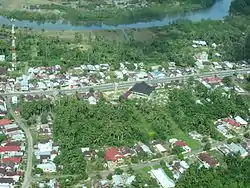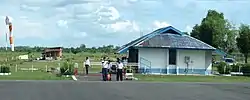Mukomuko Regency
Mukomuko is a regency of Bengkulu Province, Indonesia, on the island of Sumatra. It was originally part of the North Bengkulu Regency, but on 25 February 2003 that regency was split into two parts, the northwestern part created as a separate Mukomuko Regency. It covers a land area of 4,146.52 km2 and had a population of 155,753 at the 2010 census,[2] which rose to 190,498 at the 2020 census;[3] the official estimate as at mid 2022 was 196,571.[1] The administrative centre of the Mukomuko Regency is Mukomuko town.
Mukomuko Regency | |
|---|---|
 Mukomuko, the seat of Mukomuko regency. There is a university in the area called University of Mukomuko, shortened UNIM. | |
 Coat of arms | |
| Motto(s): Kapuang Sakti Ratau Batuah (Magical in His Own Area and Lucky for Other Areas) | |
 | |
| Coordinates: 2.66°S 101.44°E | |
| Country | |
| Province | Bengkulu |
| Regency seat | Mukomuko |
| Area | |
| • Total | 4,146.52 km2 (1,600.98 sq mi) |
| Population (mid 2022 estimate)[1] | |
| • Total | 196,571 |
| • Density | 47/km2 (120/sq mi) |
| Time zone | UTC+7 (WIB) |
In the 18th and 19th Centuries, it was known to the British East India Company as "Moco Moco".

History
The indigenous people of Mukomuko are the Mukomuko people, who are a part of the Minangkabau family.[4] Traditionally, in culture and language, Mukomuko is close to the Pesisir Selatan Regency in West Sumatra Province.[5]
In the past the Mukomuko area was part of the West Coast region (Pasisie Baraik) Minangkabau tribe. The Mukomuko people are an ethnic group that is closely related to the Minangkabau or the closest Minangkabau ethnic group. The Mukomuko area is also an overseas Minangkabau region which is often also called the Riak nan Berdebur namely the area along the West Coast from Padang to South Bengkulu. However, since the British colonial period, the Mukomuko area has been included in the Bengkulu administration (Bencoolen). Since then they have been separated from their comrades in West Sumatra and become an integral part of the Bengkulu region. This continued during the Dutch colonial period, Japanese occupation, until the independence period.
During the independence period, the Mukomuko region was included in the North Bengkulu Regency. The subsequent division of regencies and cities has occurred in almost all provinces in Indonesia, including Bengkulu Province. In early 2003, the province added five new regencies (as stipulated by Law No.3 of 2003), namely North Bengkulu Regency was divided into North Bengkulu Regency and Mukomuko Regency. The South Bengkulu Regency was also divided into South Bengkulu, Seluma, and Kaur regencies, while Rejang Lebong Regency was divided into Rejang Lebong, Kepahiang and Lebong regencies.
Similar to other districts in Bengkulu, Mukomuko was also affected by an earthquake, where on 13 September 2007, an earthquake devastated a part of the population of Mukomuko, especially in the Lubuk Pinang District.
Sending transmigrants to Bengkulu has flared up again since 1967. In fact, Presidential Decree of the Republic of Indonesia Number 2 of 1973 stipulates Bengkulu Province and nine other provinces as transmigration areas outside Java. One of the transmigrant destinations is Bengkulu Utara and this policy continues to this day. In 2004 Bengkulu still received additional transmigrants. Each transmigrant family is provided with two hectares of land. The majority of transmigrants from Java are farmers. Now these migrant population centers have grown into economic centers.
Population growth is very fast with this transmigration program. This has also caused a change in the composition of the population in the Mukomuko Regency area. Currently, the number of immigrants from Java has far exceeded the number of natives of Mukomuko. So that in reality today, indigenous people are a minority in Mukomuko Regency.
Tourism
Attractions in Mukomuko Regency include: Abrasion Beach (But Lauik), Beautiful Lotus Lake, Wide Lake, Nimbung Lake, Manjunto Air Dam, Fort Anna (Benteng Anna), Air Rami Beach, Pandan Wangi Beach, the dam which was inaugurated by President Soeharto is located in Kec.V Koto and no less interesting is Turtle conservation, located in the village of Retak Ilir, Ipuh District.
The local cultural heritage, which includes the cultural splendor and history of the kingdom, can be explored by both domestic and foreign tourists visiting this Regency, and will continue to be preserved for the sake of the continuity of the legacy of the past and history.
Administrative Districts
Mukomuko Regency is divided into fifteen districts (kecamatan), listed below with their areas and their populations at the 2010 census[2] and the 2020 census,[3] together with the official estimates as at mid 2022.[1] The table also includes the locations of the district administrative centres, and the number of administrative villages in each district (totaling 148 rural desa and 3 urban kelurahan - the latter all in Kota Mukomuko District).
| Name of District (kecamatan) | Area in km2 | Pop'n census 2010 | Pop'n census 2020 | Pop'n estimate mid 2022 | Admin centre | No. of villages |
|---|---|---|---|---|---|---|
| Ipuh | 195.99 | 16,304 | 19,044 | 19,567 | Medan Jaya | 16 |
| Air Rami | 116.42 | 10,235 | 13,115 | 13,588 | Arga Jaya | 12 |
| Malin Deman | 861.79 | 6,317 | 6,828 | 6,967 | Talang Arah | 7 |
| Pondok Suguh | 535.11 | 11,033 | 13,591 | 14,031 | Pondok Kandang | 11 |
| Sungai Rumbai | 335.97 | 6,605 | 9,076 | 9,463 | Gajah Mati | 9 |
| Teramang Jaya | 412.55 | 9,893 | 12,421 | 12,846 | Pasar Bantal | 13 |
| Teras Terunjam | 84.60 | 6,888 | 7,977 | 8,190 | Teras Terunjam | 8 |
| Penarik | 308.87 | 20,412 | 24,407 | 25,132 | Lubuk Mukti | 14 |
| Selagan Raya | 440.95 | 8,326 | 10,654 | 11,037 | Sungai Ipuh | 12 |
| Kota Mukomuko (Mukomuko town) | 148.07 | 15,005 | 18,604 | 19,218 | Pasar Mukumuko | 9 |
| Air Dikit | 87.89 | 5,622 | 7,112 | 7,360 | Dusun Baru V Koto | 7 |
| XIV Koto | 69.86 | 10,693 | 13,623 | 14,107 | Lubuk Sanai | 8 |
| Lubuk Pinang | 69.51 | 12,545 | 14,653 | 15,055 | Lubuk Pinang | 7 |
| Air Manjunto | 65.24 | 8,928 | 11,511 | 11,933 | Manjunto Jaya | 8 |
| V Koto | 393.72 | 6,947 | 7,882 | 8,077 | Lalang Luas | 10 |
| Totals | 4,146.52 | 155,753 | 190,498 | 196,571 | Kota Mikomuko | 151 |
References
- Badan Pusat Statistik, Jakarta, 2023, Kabupaten Mukomuko Dalam Angka 2023 (Katalog-BPS 1102001.1706)
- Biro Pusat Statistik, Jakarta, 2011.
- Badan Pusat Statistik, Jakarta, 2021.
- Agus Setiyanto, Elite Pribumi Bengkulu: Perspektif Sejarah Abad ke-19, Balai Pustaka, 2001
- Suwarno, Sintaksis Bahasa Muko-Muko, 1993